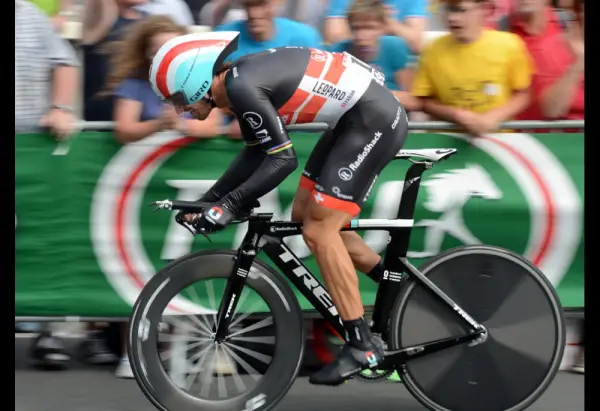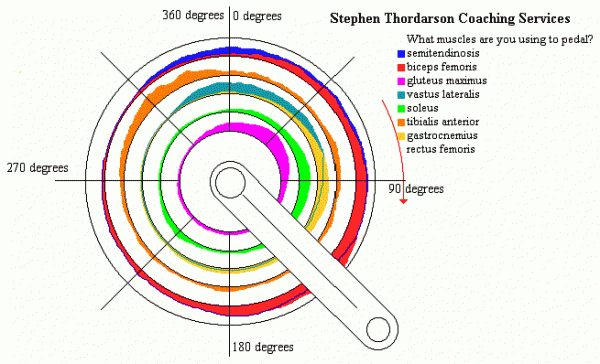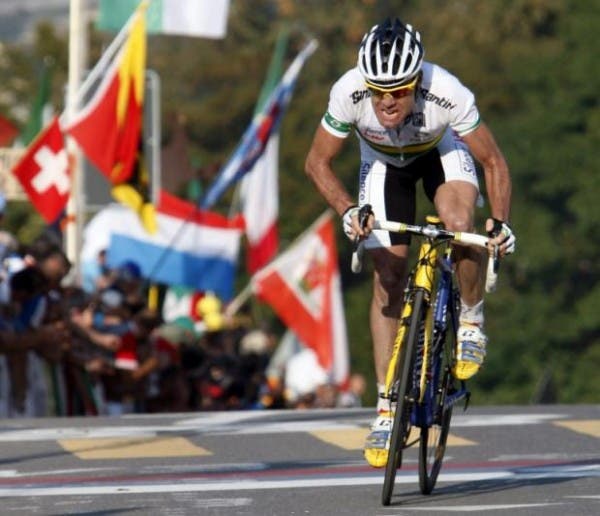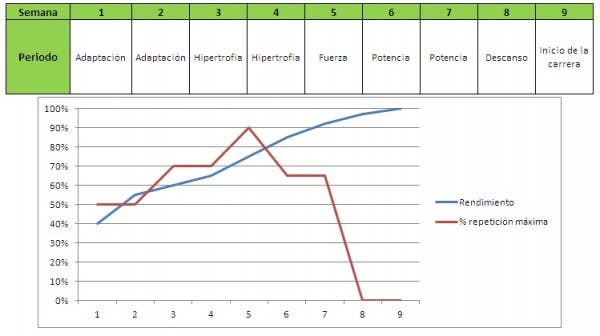Undoubtedly, when we talk about “cycling” and “gym” in the same sentence, many people think that they are completely incompatible. After all, most cyclists practice long-distance cross-country tests at a more or less constant pace, so doing squats or any strength program seems of little use to them. Also, a rider tries to be as light as possible so that his body weight offers the least resistance.
Cyclists, gymnasts, footballers, runners, swimmers, women, wrestlers… many groups make the fatal mistake of associating work in the gym with “growing too much for their needs”. They forget the benefits that physical work can bring them in the gym simply by looking at photos of professional bodybuilders (with all the chemistry involved).
Having already clarified the enormous benefits that squats offer to runners, footballers, gymnasts and swimmers, at the suggestion of our followers @ ciriaco1965 and @Dgcycling, we ventured to find out the benefits they bring to cyclists in this last article of the “week of squats ”.

Cyclists need leg power
A cyclist, whatever his specialty, must maximize the power of his pedaling. The greater the power applied to the pedal, the more distance it will travel . This is a fact of vital importance since the attacks or changes of rhythm will be faster and easier to carry out, in addition, the cyclist can reserve forces if with each pedal he covers a greater distance.
In numerous interviews with cyclists such as Lance Armstrong and Fabian Cancellara, in addition to all cyclists on the track, they recognize the need to perform strength and power programs, especially in the form of squats, during pre-competitive periods and when reaching a “peak” so.
Squats work the muscles used in running

Semitendinosis and biceps femoralis belong to the hamstrings. Soleus, tibialis anterior and gastrocnemius belong to what we commonly know as “twins”, although the tibialis anterior is located on the shin. Vastus lateralis belongs to the quadriceps. Gluteus maximus belongs to the glutes.
This scheme is undoubtedly a work of art. With just this image, which represents the activation of each muscle during the cycle of a pedaling, the excellent trainer Stephen Thordarson explains the importance of the most important muscles of the lower body in cycling.
Contrary to popular belief, in a normal pedal stroke, the quadriceps are not the most important muscle group. This fact has already been repeated with shooting in football and it is what makes the squat such an important exercise: if the strokes and the shots were quadriceps-dominant, the leg extensions would be a good exercise and, nevertheless, their impact it is practically nil in the performance of cyclists.
Squats offer some gains in strength and enormous potenci the hamstrings and glutes. In addition, squats also work the calves and there is the possibility of finishing them on tiptoe in order to work this muscle group more.
The importance of squats in reaching peak form
In any sport, performance fluctuates throughout the competitive season. This is due to the impossibility of working 100% always, since a program of this type would fatigue the athlete in a superhuman way, ending in low performance and possible injuries. For this reason there is, in any sport, periodization.
Periodization consists of taking the athlete to peak fitness, that is, to periods of peak performance, for important events. These peaks of form are more evident, if possible, in cycling, where each rider prepares a competitive calendar at the beginning of the season.

Could this periodization really be controlled just with bicycle workouts? It is more than obvious: no . While these workouts are necessary, they are not the only ones. The bicycle training aims to simulate certain situations such as cobbled terrain, steep slopes or sprints to improve the technical aspect of the cyclist. Also say that resistance is greatly improved in previous concentrations, however these workouts have a questionable impact on the power of the cyclist.
It is simple, in sports where there is no resistance (weight or ballast) continuously making an effort without varying this factor supposes the adaptation of the body, not improvement. The cyclist will be able to sprint for endless minutes, he will be able to adapt his body to situations of enormous accumulation of lactic acid and, nevertheless, since the resistance (his own weight on the bicycle) is always the same there is no progression. To be more exact, there is no progression in potency .
It is true that you can change the chainrings or sprockets to change the resistance offered by each pedal stroke but, nevertheless, here we forget an important factor: you will never sprint with the same combination with which you climb. It could be said that this fact could be compared to ” rude ” the cyclist.
Here is the figure of strength and power training, therefore also squats, offering more than notable improvements. However, we have not yet discovered its importance in form peaks. Relax, let’s get to it.
It is impossible to squat 100% from minute 1. A cyclist’s periodization follows these guidelines:
- The cyclist needs an adaptation to training that will start with a training of 10-12 repetitions with the aim of introducing the following phases. It will last a minimum week, a maximum of two with loads at 50-60% of the maximum repetition.
- The period of hypertrophy begins, that is, of muscle growth. It is impossible to increase power without increasing size but you do not have to worry about the weight gained (which will not be much either) because it will all be useful weight: muscle weight. During this period the repetitions will be 6-10. It will last two weeks with loads at 60-75% of rep max.
- The penultimate period will be the maximum strength period , with a repetition range of 1-5. It will last at least a week with loads at 80-100% of rep max.
- Finally, the power period. It will last two weeks with 60-75% loads, however the important thing is not the weight or the repetitions, but the speed at which the movement is performed. During this period the squats become quick squats or even jump squats .
Just at the end of this period, the cyclist will be able to perform above his previous 100%, being muscular and mentally prepared (central nervous system) for any race. It is obvious that the cyclist will never perform any type of strength training from a week before his competition to avoid accumulated fatigue .
Let’s look at an example of periodization:

It may seem strange that during the break the performance continues to increase but it is normal. It is clear that these workouts are fatigued and, during the first break, the muscles remain in tip-top shape as well as being more rested .
Squats can always be performed
They are carried out in a closed enclosure, unlike bicycle training, so that rainy days, with snow, with a heat wave or with suspended African air particles do not suppose any climatic impediment in their realization.
Variants for cyclists
Coaches of volleyball, soccer, rugby, basketball, etc. advise their athletes to perform partial movements to improve their performance and their vertical jump, that is, the power of their legs. While this method is effective for performance, half squats carry a structural imbalance by developing the upper quadriceps without taking the lower part into account. After a few months the so-called “jumper’s knee” appears.
However, there is a muscle in the quadriceps closely related to sports performance, more so in cyclists: vastus medialis oblique (VMO) . This muscle is perfectly recognizable, it is the teardrop-shaped portion of the quadriceps. What is the importance of this muscle? It is essential for the stability of the knee .
Never forget stability, never. In any athlete, stability has to be above strength because otherwise all effort will be useless. Let’s see it with a practical example.
Suppose we have to push a lever with all our might to lower it; We have two situations: a) the lever is embedded in a slot preventing it from moving sideways, b) the lever is free, it can move to either side. In which of the two cases will it be easier to move it? Obviously the correct answer is a) since we only want a vertical movement, any horizontal movement that occurs will be a loss of energy.
Is there any similarity between this example and cycling? Of course, if not, I wouldn’t say it. Imagine that that lever is your knee and that the force that you apply instead of being with the arms is with quadriceps, hamstrings and glutes. If your VMO is well developed you will have a stable plane on which to pedal, you will not lose strength in stabilizing the knee as well as avoiding injuries.
For this reason, a cyclist must specialize his training with squats to the development of VMO, which can be done in two ways:
- Using a specific foot position: first variant of the cyclist squat (boy, what a coincidence the name). Coach Charles Poliquín uses this type of squat with all his cyclists, it consists of performing a squat with a very narrow leg opening and a wooden block placed in the heels. Nothing better than a video to understand the movements.
- Overloading the final portion of the squat: squat and a quarter . It consists of squatting to the deepest position, going up a quarter of the way, and going back down to the bottom to go up again. That is a rerun. The illustrative video I leave you with the following variant.
- Performing both at the same time: second variant of the cyclist squat . Illustrative video.
Sources
Charles Poliquín
FasCatCoaching
